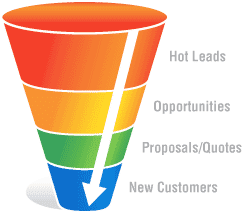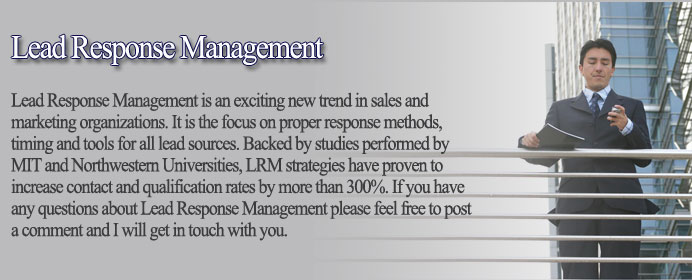Friday, December 26, 2008
What makes a good Lead Status?
It is important when selecting statuses or stages that you think of them as place holders for your leads (not descriptions of) as they progress through your linear sales, processing and/or support processes. For example; a lead status of attempting contact makes sense because it is in a place holder where activities are taking place to establish contact. On the flip side; busy number is not a good status unless you treat busy phone numbers differently than you do any other un-contacted lead.
A simple example: New (never been dialed); Attempting Contact (receiving active contact attempts); Nurture (failed to contact and is now receiving passive contact attempts); Not Interested (spoke with the person and there is no interest); Bad Lead; Investigating (contacted and in the sales process); Closed Won; and Closed Lost.
If you want to track reasons why a lead was not interested, those should be tracked in a sub drop down list which can be accessed for reporting purposes.
These statuses or stages should also have detailed plans on how to progress them into the next status. If in “Attempting Contact”, we will use a power dialer to call 3X per day, send an email every 3 days, a fax every 10 days and leave a recorded voice message every 3 days. If we get a hold of the person, move it into either “Not Interested”, “Investigating” or “Nurture”. If we do not get a hold of it, move it into “Nurture” after 3 weeks.
So we can see Statuses do not describe the lead itself but the stage in which it is residing and the activities that are associated with it.
Tuesday, October 14, 2008
Sales Funnel or Sales Colander?


One can’t simply patch the wholes in a colander and call it a funnel. Both are fundamentally different. Just imagine that you have both a colander and a funnel sitting in front of you with a bucket of water. Pour some water in the colander. The water will go straight through with quite a bit spilling through the side walls. Now pour some water in the funnel. You will quickly notice that the water starts to spin in the top of the funnel, gaining momentum and velocity as it enters the smaller neck area and eventually shoots out the bottom in a more refined stream of water. You should also notice that in order to get more water directly out of the bottom of the colander, you need to increase the amount of water that goes in at the top. Not so with the funnel. The funnel itself either needs to be expanded or the speed of the water needs to be increased in order to get more output.
Let’s look at a traditional sales funnel.

You will notice that the leads go in the top and new customers come out the bottom. That is the goal. It is the process of taking an input, interacting with it and getting a completely different output. Naturally there will be some waste in that process, right? The first step in creating our True Funnel is to think of it on a linear level. Define the natural progression from lead to customer. You may include some marketing steps in the process as well if you would like. The True Funnel should include demand generation and other marketing practices.
Now that you have that linear process mapped out, let’s apply some lessons which we have learned from industrialization. The first is specialization. Keep the Sales teams selling. Keep the Marketing teams marketing. How do you bridge the gap? Lead Generation and Lead Qualification teams. Let’s not kid ourselves, sales reps don’t want to become telemarketers. They don’t want to “Smile and Dial”. They don’t want to make more than 30-40 phone dials a day. Which means your leads are not being worked effectively enough. A Lead Gen. or Lead Qual. team can be used to contact new leads within an acceptable time frame and/or continue to attempt contact beyond the standard 3-4 attempts performed by a sales team. Once contacted, that team should simply perform a quick pre-qualification to make sure they are talking to the right person and there is some level of interest, at which point, the lead is sent on to the next station in the assembly line for further fabrication.
The second lesson to be learned is automation.

Look at the picture above. Notice the harmony of man and machine working together to build something wonderful. In an assembly line, machines are often used for repetitive simple tasks, complex precision task, quality assurance, and to report on the status of the line. Technology can be used in similar ways on a sales assembly line. Simple repetitive tasks which can be automated are dialing numbers, leaving voice messages, sending emails, logging activities, scheduling events, and setting reminders. Technology can also be used for precision tasks such as lead capture, lead routing, de-duping, neglected re-routing, immediate response, and campaign strategy.
At a minimum, you should employ some level of analytics for tracking your demand generation activities, a lead response management system for facilitating your response strategies and a customer relationship management solution for managing your pipeline and beyond. It is highly important to have these and other systems communicate or integrate one with another. A key benefit of using technology is oversight and reporting, and if your technologies don’t communicate well, you will lose many key metrics.
Finally we need to address the seepage. If you notice, in a funnel, water that is not ready to leave the bottom stays in a swirling pattern in the top end of the funnel. This is such a perfect metaphor because your leads shouldn’t fall out the sides of your funnel, they should swirl around in the top end until they are ready to slip through the selling end. This is accomplished by nurturing activities. Nurturing activities will take a lead, where its progress is halted, and reinforce it with marketing and educational material. Additional touches by a representative within your organization also help prepare the lead for progression. If these activities are completely automated then the only reason why a lead should ever leave the funnel is if it is disqualified and asked to be removed from any future correspondence at which point it spills out the top of the funnel and stops taking up space.
Tuesday, September 30, 2008
Difference between Marketing and Sales
Here is a quesiton to get you thinking; why would there be a difference (and it was overwhelmingly obvious) between Marketings and Sales approach? I would have thought it would have been the opposite. Maybe Marketers are leaning more towards nurturing a lead and bringing it around slowly where as Sales has a quota and wants to exhaust all resources in the attempts to get the deal.
No real answer, just some points to ponder. Please comment with your thoughts.
Tuesday, September 16, 2008
New Marketing
Recently I have been turned on to a new way of marketing. I don't know how new it is but it warrants mentioning on my blog. It is Service Marketing. Service Marketing doesn't just provide information, but it provides a service. There are some key components when creating a service for your company that can act as a lead generator:
- It must relate to your product of service.
- It must be offered, in a limited manner, for free at first.
- It must have value in and of itself.
- It should be offered at a very low price to eliminate any barrier to the prospect doing business with you.
If done successfully, you could end up with a double opt-in buyer lead that has a relationship with your company.
Here is an example:
Call 1- Hi, We have performed an audit on your hold times for customer service. Are you interested in the results?
This is opt in #1
Send results
Call 2- Hi, we did a study on the importance of handling customer service calls in a timely manner. Would you be interested in a copy of that study? I will also attach information on the audit as a service we offer.
This is opt in #2
Send study and brochure talking about the service you provide. The cost should be a no brainer. Much less than what they can hire an $8 per hour high school student to sit on hold and report times back to them.
If they buy, they now have a relationship with you and are a double opt in buyer lead for your real products and services.
If you need some ideas on services you can offer, feel free to email me at troy.bingham@gmail.com.
Thursday, August 7, 2008
One call close
Recently, I was asked to help put together a response strategy for a client of ours. This client produces an infomercial, among other marketing activities, to generate inbound callers looking to purchase a product where a portion of the proceeds go to a specific charity. Their goal was to figure out a way to stay in touch with the people that don't buy on that initial phone call.
This one was easy. In my mind there is only one primary reason why anyone would call a phone number off of an infomercial and not buy; the price. They have proven to be interested in the product and/or cause (otherwise they wouldn't have called in the first place). So, here is the strategy:
- Take the inbound call
- When the person says that they are not interested, request email address for additional information about the cause.
- Email 1 (same day). "Thank you for your interest in the cause. I understand that situations are different for everyone and not everybody can participate at the level we were requesting. Periodically, we like to offer alternative methods of participation to a few select individuals. As a result of the interest you have shown thus far, I will assume that you are interested in being notified of these opportunities to make a difference unless you let me know otherwise. Again, thank you for your thoughts and prayers on behalf of ...."
- A week later send an email announcement talking about the cause. DO NOT request anything from your prospect.
- A couple weeks later do the same thing as step 4.
- Three months and several email newsletters later send an email saying: " dear...., I appreciate your interest in.... and willingness to act. As I mentioned a few months ago, we occasionally have alternate opportunities to provide your support to.... Later this week, we will be contacting you with a pre-recorded message detailing the opportunity and requesting your help.
- A couple of days later send a prerecorded message: “Occasionally, we here at .... Try different things to extend the opportunities to help, to those that otherwise can’t. Previously we offered (name the product) at a price of (name the price) with the proceeds being donated to (name charitable organization). For a limited time, we are allowing interested people in combining their efforts and contributing as a team. This is only being tested with a limited number of people. If you are interested in more information, press 1 and you will be put in touch with one of our representatives. If the timing is still not right for you, but you are still interested in helping in the future, press two and we will continue to keep you posted on news about...
When they press one, ask them if they are in a better position to contribute the full amount, if they say no, let them know that they can contribute 1/5 the amount and be a part of a group effort.
The whole point is to turn the lead, which was previously dead, into any amount of money. If they are still unable to participate, repeat the steps until they buy or tell you to stop.



